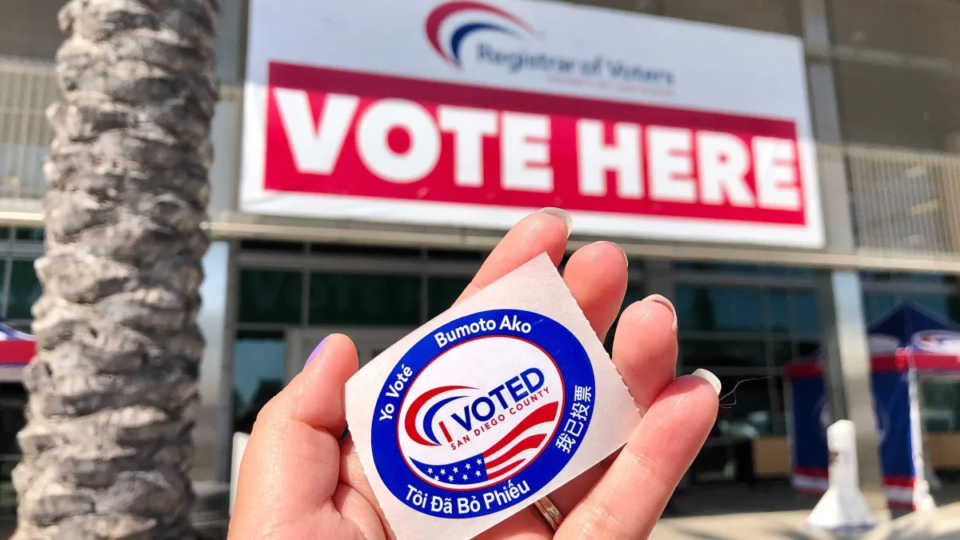Republicans make ground with Latino voters, but the County remains somewhat tepid on Trump. For both Parties, San Diego is still in play.
Nationally, the 2024 elections were, beyond any doubt, a red wave. From Donald Trump’s historic re-election to the latest projections which suggest that Republicans will control both the House and Senate, conservatives will have much to celebrate. San Diego County, on the other hand, defied this trend somewhat. While Democrats certainly did not have a clean sweep in the region, they did largely hold steadfast with San Diego’s electorate and emerged victorious in several key battlegrounds.
More than that, San Diego County races were, as of the time of writing, decided almost entirely on the basis of incumbency. Depending on one’s perspective, it could be argued that the 2024 elections proved the need for experienced leaders at the helm—or perhaps only proved the difficulty of upending the status quo.
Here we offer a look into the results of the region’s most closely-watched and hotly-contested races.
San Diego City Council
Overall, it was a great year to be an incumbent—especially a Democrat incumbent. This trend is absolutely apparent in San Diego’s City Council races. This cycle, Districts 3 and 9, as well as the at-large position Mayorship, were on the ballot. All three were won by the sitting Democratic incumbents; Stephen Whitburn in District 3; Sean Elo-Rivera in District 9; and Todd Gloria in the contest for Mayor. As such, the progressive wing led by Elo-Rivera will retain a majority control.
While neither were incumbents, the two candidates for City Attorney were also Democrats. Heather Ferbert—who had the backing of progressive coalitions such as the Pacific Beach Democratic Club, San Diegans for Gun Violence Prevention, and the San Diego La Raza Lawyers Association—triumphed over termed-out Assemblyman and San Diego County Democrat Party endorsee Brian Maienschein.
Congressional Districts
San Diego County’s Congressional races were, perhaps unsurprisingly, among the most closely watched in the nation. It is worth noting that some remain undeclared due to the volume of remaining ballots. Nevertheless, some conclusions can be drawn from the existing data.
In the 49th Congressional District, which covers coastal north San Diego County and southern Orange County, incumbent Democrat Mike Levin is likely to be re-elected. He currently leads Republican challenger Matt Gunderson by 4 percentage points which is—as of now—too close to call. Even if Republicans fail to flip the seat, it is notable that they have whittled down on the margin of defeat each year since Rep. Levin was first elected; from 13 points in 2018 to 6 points in 2020, 5 points in 2022, and now—potentially—4 points in 2024. However, that lead does appear to be widening.
Most of Rep. Levin’s support has come from San Diego, where he currently leads Gunderson by about 30,000 votes. In Orange County, Gunderson is 15,000 points ahead. Altogether, the moderate Republican trails Rep. Levin by around 14,000 votes.
The results are even more decisive in Congressional District 50, where Republican challenger Peter Bono trails Democrat incumbent Scott Peters by an impressive 28%, and District 52, where Republican challenger Justin Lee fell an even more staggering 32% behind Democrat incumbent Juan Vargas. Similarly, in District 51, where Republican challenger Bill Wells is 11 points behind Democrat incumbent Sara Jacobs.
The one arena where Republicans were the victors was in the 48th Congressional District—another instance of incumbent advantage—wherein Rep. Darrell Issa defeated his Democrat challenger by just under 20 points. In all instances, the Associated Press has called the races for their sitting representatives.
Assuming Gunderson does not come up from behind, all of the Congressional Districts within San Diego County will remain as they were in 2022—ultimately not contributing to the shifting balance of power in Washington.
Of course, there’s also the U.S. Senate race, where Democrat Adam Schiff leads Republican challenger Steve Garvey by roughly 13 percentage points.
State Assembly & Senate
San Diego County’s State Assembly Districts are similar to its Congressional Districts in that it’s unlikely any of them will flip from blue to red or red to blue—with the only exception being the one it shares with Orange County. In Assembly District 74, Republican incumbent Laurie Davies is currently only a nail-biting 2.5% ahead of Democrat challenger Chris Duncan. As with CD-49, the support for the Democrat candidate comes mostly from San Diego while the Republican candidate leads in Orange.
“It’s clear the final result will be very close,” San Clemente Councilmember Chris Duncan stated.
“We’ll have to wait and see until everything is counted,” Davies said Wednesday.
Republicans remain hopeful that Davies will retain the seat, but it’s still far too close for comfort. The only other Assembly District they will hold in San Diego County is the 75th. Previously held by Rep. Marie Waldron, the State Assembly Minority Leader from 2018 to 2022, the District’s current representative did not file for re-election. It’s a contest between Republicans Andrew Hayes and Carl DeMaio. DeMaio—a well-known radio host—enjoys a 15% lead.
Democrats will almost assuredly hold AD-77 (where Democrat incumbent Tasha Boerner leads Republican challenger James Browne by 20%), AD-78 (where Democrat incumbent Chris Ward ran undefeated), AD-79 (which Democrat incumbent Akilah Weber vacated to run for State Senate and which is now a battle between Democrats LaShae Sharp-Collins and Colin Parent, with Sharp-Collins ahead by 6%), and AD-80 (where Democrat incumbent David Alvarez is 20% ahead of Republican challenger Michael Williams).
What’s less certain is the fate of CA AD-76. The seat was up for grabs, as Democrat incumbent Brian Maienschein termed out and was ineligible to run in 2024. It became a fiercely-fought contest between Republican Kristie Bruce-Lane and Democrat Darshana Patel. While it hasn’t been called, Patel is the favored winner with a 7 point lead.
The only State Senate race on the ballot this cycle was the 39th District. It’s a blue district currently held by Democrat Toni Atkins, who did not seek re-election. As previously mentioned, Assemblywoman Akilah Weber—the daughter of California Secretary of State Shirley Weber—threw her hat into the ring, as did Republican Retired Navy Commander Bob Divine. Weber leads by just under 26%, meaning the seat will stay in Democrat hands.
Board of Supervisors & More
All eyes were on the three County Board of Supervisors races—especially District 3. It was a contest between two heavy-hitters: Democrat incumbent and the County’s first pansexual, non-binary Supervisor, Terra Lawson-Remer, and former San Diego Mayor Kevin Faulconer, a Republican. The outcome of the race would determine whether conservatives or progressives would wield power on the Board.
Supervisor Lawson-Remer, who had been appointed to the Board of Supervisors in 2021, is known for her focus on progressive issues like climate action, social justice, union advocacy, and expanding affordable housing. Faulconer, on the other hand, ran on a platform of fiscal responsibility, improving public safety, and reducing government spending. Both candidates sought to reduce homelessness in their own ways, with Faulconer arguing that under Lawson-Remer’s tenure, the County’s rate of homelessness had only gotten worse while the City of San Diego’s got better under his.
After a tense and hard-fought campaign, Terra Lawson-Remer emerged the winner with a 13% lead.
Fellow progressive Supervisor Nora Vargas also won re-election in District 1 with a 25 point lead over her opponent while conservative Supervisor Joel Anderson retook District 2 by 20%.
If nothing else, these metrics should reveal the incumbent advantage with great clarity. If everything holds, then there will not be one instance in any of the aforementioned examples where a challenger defeated an incumbent or flipped a seat for their Party.
But what about when there’s not an incumbent on the ballot? In most of the examples given where an incumbent was not present, the contest was between two candidates of the same Party—which offers little insight into the overall political leanings of the county as a whole. For that, the best measure is still, perhaps, the Presidential election.
While San Diego County remains a far cry from the deep-blue Counties of Los Angeles or San Francisco, it was decidedly tepid on Trump. While just under one-third of ballots have yet to be counted, Harris currently leads Trump by a near-insurmountable 16 percentage points. That will, of course, have no effect on the long-since decided Presidential race—but it remains an interesting metric to gauge the popularity of the MAGA movement in California’s second-most populous county.
And yet, the majority-Latino areas of San Diego County shifted toward Donald Trump by wide margins—as much as a 13-point swing in some districts. Public policy analyst Vince Vasquez asserts that this “probably isn’t a once-in-a-generation phenomenon,” but a “longer-term political realignment.”


